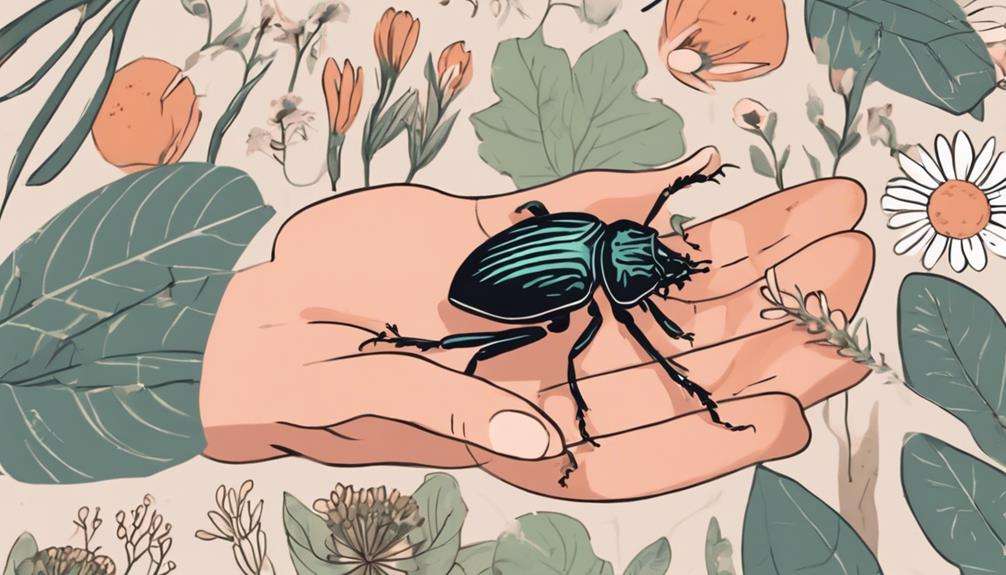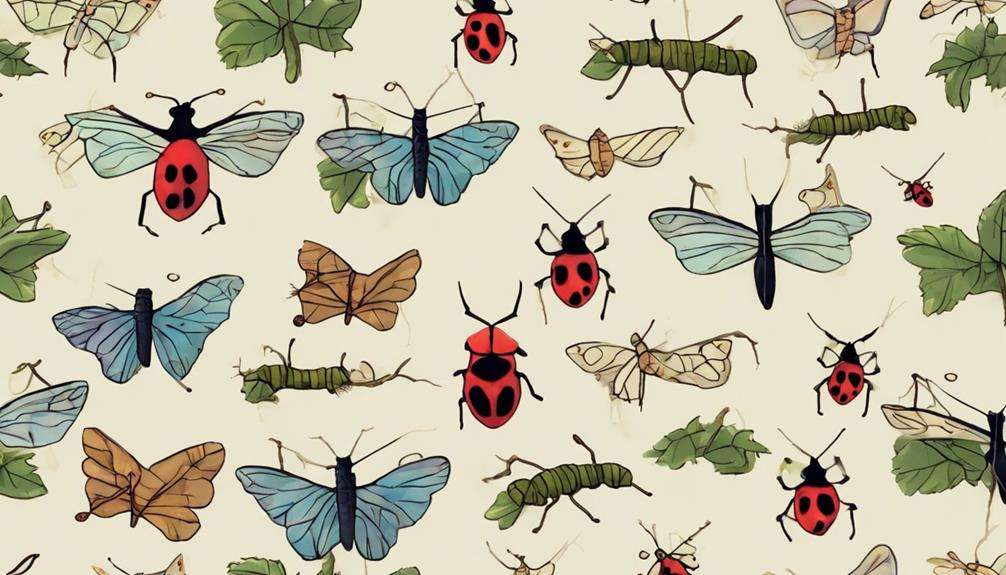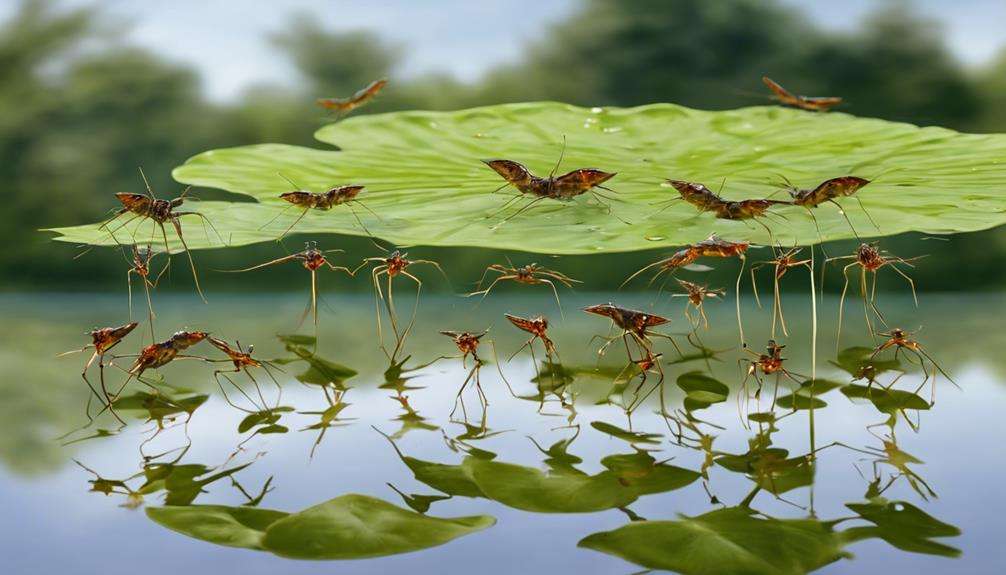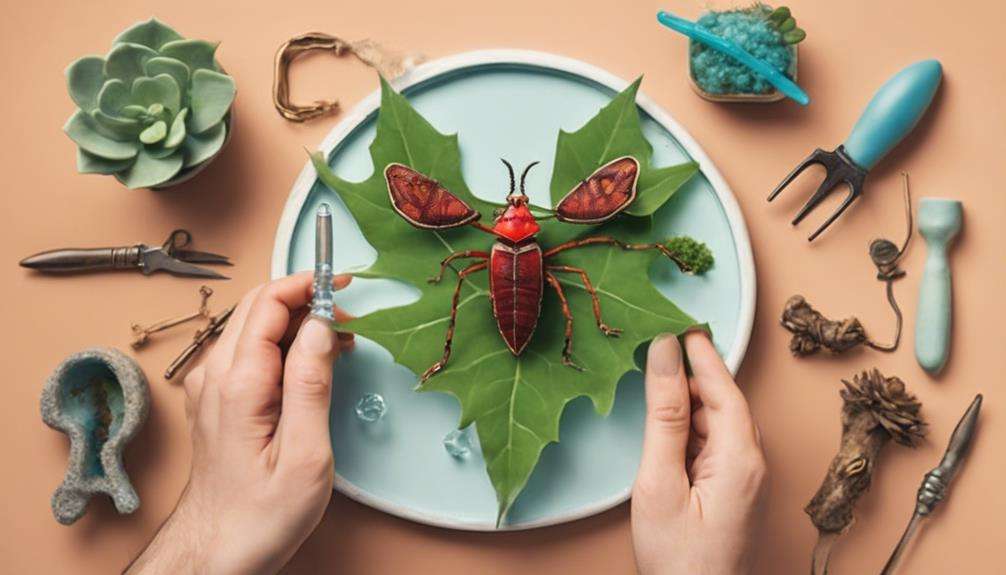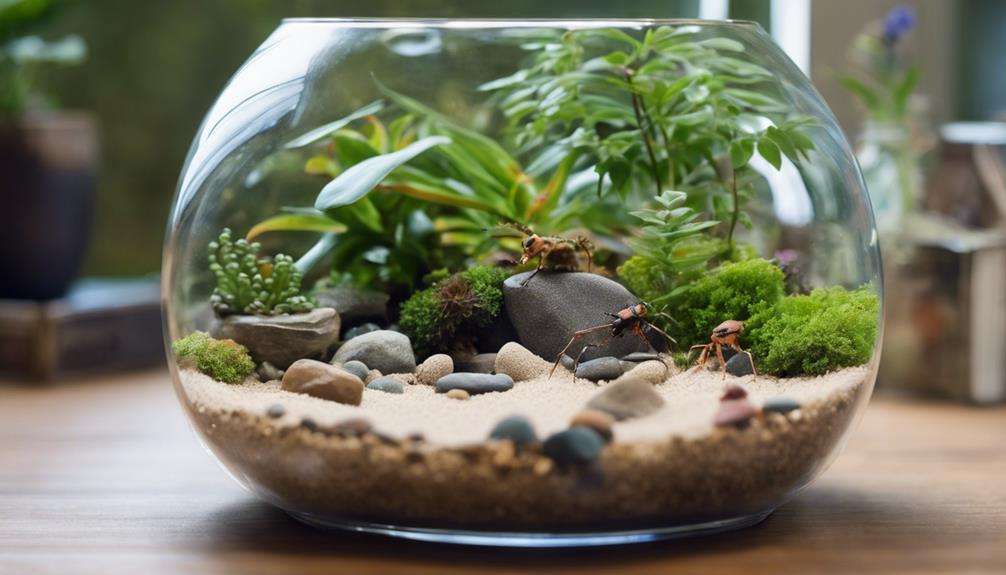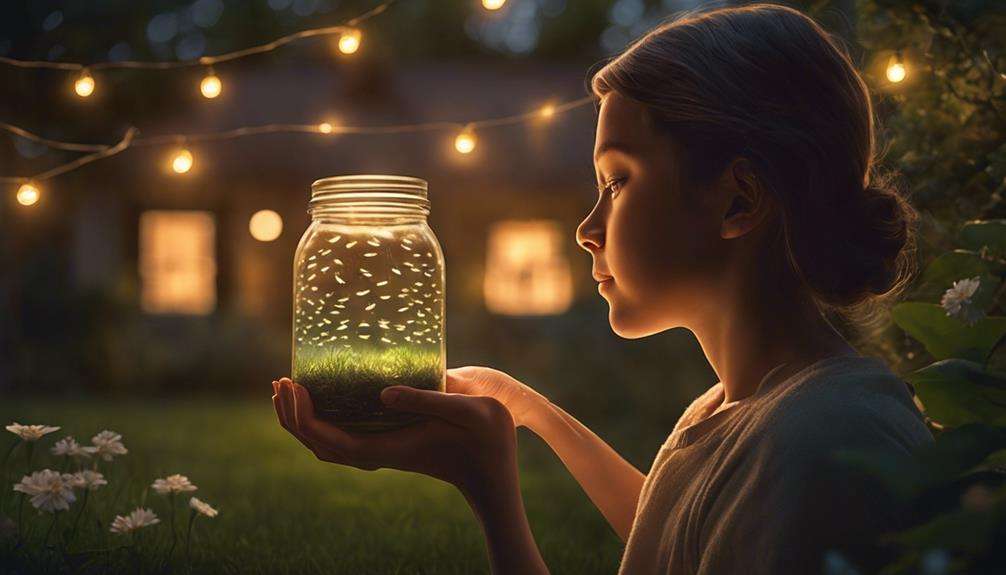You know, stick insects are ideal for terrariums because of their fascinating habits and unique characteristics.
Their ability to blend in perfectly with their surroundings adds an intriguing element to any terrarium setup, making them a captivating addition to your collection.
But there's more to why stick insects are highly recommended for terrarium enthusiasts.
Key Takeaways
- Stick insects blend well in terrariums, enhancing the natural aesthetic.
- Glass terrariums are essential for their well-being and containment.
- Stick insects thrive in controlled environments with ideal temperature and humidity.
- Terrarium setup offers a safe, visually appealing space for observing stick insect behavior.
Benefits of Housing Stick Insects
Housing stick insects in terrariums offers numerous advantages, making them an excellent choice for both beginners and experienced hobbyists. Stick insects need a glass terrarium to guarantee their well-being, as it provides a secure environment for their thriving. One key benefit is the ease of cleaning – stick insects require a clean environment, and a glass terrarium allows for easy observation and maintenance.
Feeding stick insects in a glass terrarium is also simplified. You can easily monitor their food intake and remove any uneaten portions promptly. Additionally, stick insects need to be housed in a glass terrarium to prevent escape, as they're adept at hiding and can easily vanish in other types of enclosures.
Regular cleaning of the glass terrarium is essential for stick insects. You should clean their living space every week to assure hygiene and a healthy environment. This routine maintenance not only benefits the stick insects but also facilitates better observation of their behavior and growth.
Ideal Terrarium Size for Stick Insects
To guarantee the best living conditions for stick insects, the perfect terrarium size must be carefully considered based on their specific requirements for space and molting success. Make sure the terrarium is at least 3 times the body length of the stick insects in height and 2 times in width. This sizing guarantees that the insects have ample room to move around and molt comfortably.
The dimensions of the terrarium play a vital role in the overall well-being of stick insects. A glass terrarium is ideal for housing stick insects as it provides visibility and containment. Additionally, the roof of the terrarium should be made of netting or mesh to facilitate successful molting.
Ensuring the proper size of the terrarium is essential for creating a suitable environment where stick insects can thrive and exhibit natural behaviors. By providing adequate space, you contribute to the health and happiness of your stick insects, allowing them to molt successfully and grow without hindrance.
Temperature and Humidity Requirements
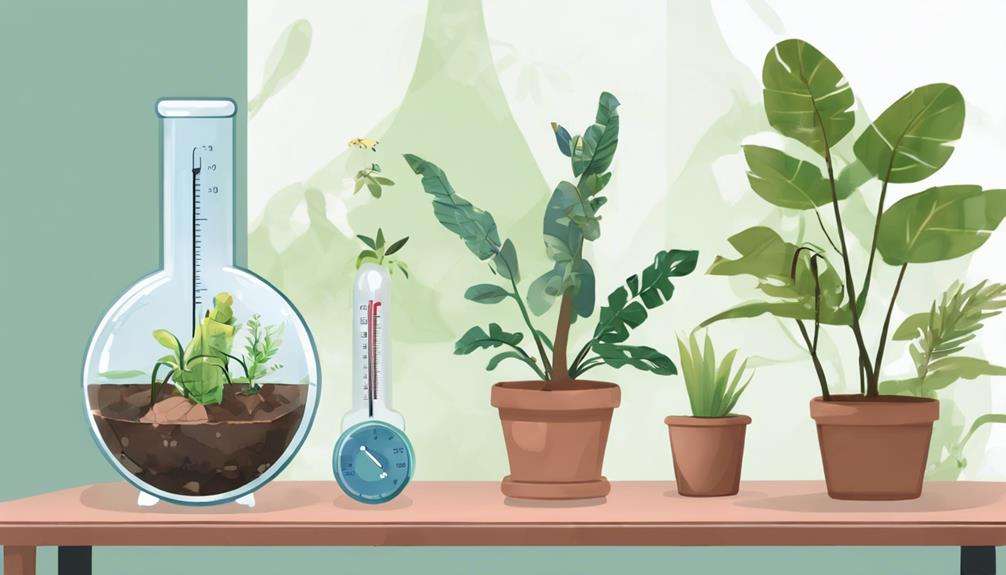
Maintain a temperature range of 20-25°C and humidity levels between 60-70% to guarantee the well-being of your stick insects.
Proper regulation of these environmental factors is vital for their molting process, especially during shedding of old exoskeletons.
Stick insects are highly sensitive to extreme fluctuations in temperature and humidity, which can greatly impact their health and activity levels.
Ideal Terrarium Conditions
Stick insects thrive best in terrariums when the temperature remains consistent between 20-25°C during the day and 18-22°C at night, while humidity levels are maintained at 60-70%. These environmental control measures are essential for their well-being. Temperature regulation guarantees their metabolism functions optimally, while humidity management supports their health, especially during molting.
Some species, like the Indian stick insect, may require slightly higher humidity levels around 70-80%. Proper terrarium setup involves monitoring and adjusting these conditions regularly to prevent stress and health issues. Maintaining these ideal conditions is key to ensuring that stick insects thrive in a habitat that mirrors their natural environment and supports their growth and development.
Maintaining Proper Environment
Maintaining the ideal temperature and humidity levels in the terrarium is essential for the best health and well-being of stick insects. Environmental control plays a critical role in habitat management for these creatures. Stick insects require specific climate regulation to thrive, as different species have varying requirements.
Regular spraying of the terrarium is necessary to sustain the proper humidity levels essential for their survival. Detailed guidelines provided in species descriptions aid in creating the right environment for these insects. Monitoring and regulating temperature and humidity are important due to stick insects' high sensitivity to environmental changes.
Ensuring the correct environmental conditions is fundamental for the overall health and well-being of stick insects in the terrarium.
Suitable Substrate Options for Terrariums
In terrariums housing stick insects, ensuring the proper composition of the substrate mix is essential for their health and molting success. Stick insects thrive on a substrate mix of Peat Moss, CocoFibre, and Critter Crumble. The ideal substrate depth for these insects is around 5cm, maintaining proper moisture levels essential for successful molting.
To aid in humidity retention, keeping a thin layer of water (5mm deep) in the substrate is advisable. Regular substrate changes, ideally on a monthly basis, are necessary to maintain cleanliness and prevent mold or bacteria growth, which could harm the stick insects.
Additionally, the substrate not only plays an important role in the insects' well-being but also contributes to the overall terrarium decor. Providing the right substrate mix is fundamental for the overall health and molting success of stick insects in terrariums.
Feeding Stick Insects in Captivity
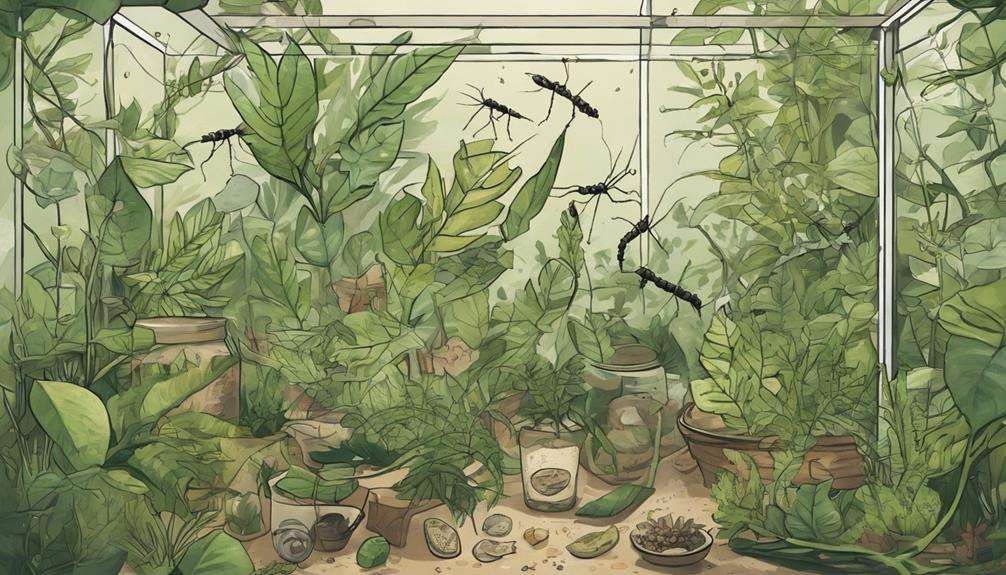
For essential health and nutrition of stick insects in captivity, it's ideal to provide fresh leaves from specific plant species as their primary food source. Stick insects have unique feeding habits and dietary preferences that vary among species, making it important to offer suitable food options.
To guarantee the well-being of stick insects, fresh leaves should be regularly provided in a vase with water to maintain their freshness and hydration levels. Monitoring food consumption is key in captivity; promptly replacing dry or consumed leaves is necessary to keep stick insects well-fed.
Different stick insect species, like the Indian stick insect, have specialized feeding requirements that must be met to thrive in captivity. By observing their food intake and preferences closely, you can track their consumption patterns and adjust their diet accordingly.
Providing a consistent supply of fresh leaves and monitoring their eating habits will contribute to the overall health and vitality of stick insects in a terrarium setting.
Handling Stick Insects Safely
To guarantee the safety and well-being of stick insects, handle them minimally and with gentle care to prevent stress and injuries. Stick insects have delicate bodies that can be easily harmed if handled roughly or improperly. It's important to avoid picking them up by their legs or wings, as this can lead to injuries. When stressed, stick insects may release defensive chemicals, highlighting the importance of minimizing handling to prevent such reactions.
Observing stick insects from a distance is recommended to make sure their well-being while reducing stress levels. Proper handling techniques involve using a soft touch and allowing the insects to move at their own pace. By following these guidelines, you can help prevent injuries and stress in stick insects, promoting a safe and comfortable environment for them in the terrarium.
Maintaining Cleanliness in the Terrarium
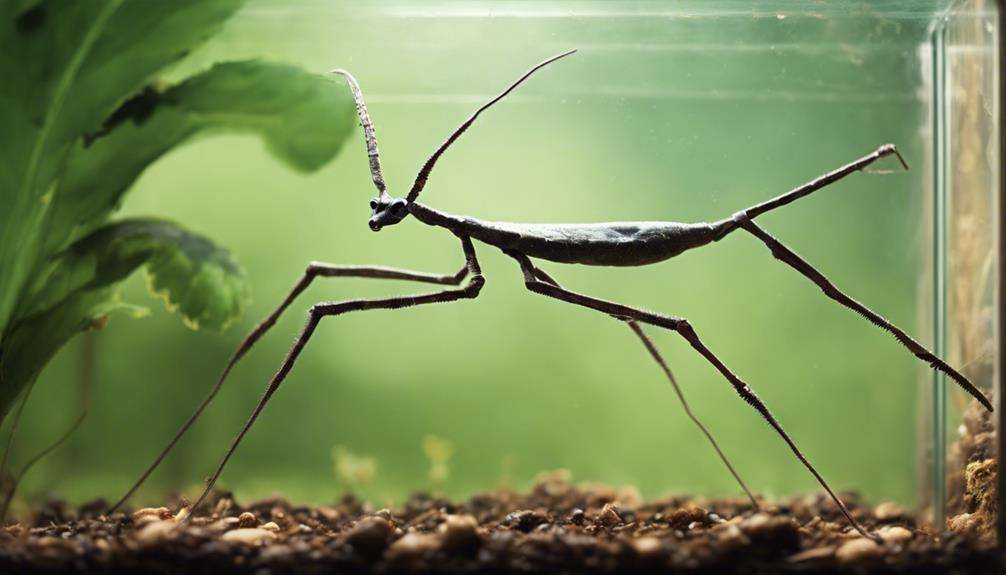
When tending to stick insects in a terrarium, ensuring cleanliness is paramount due to their droppings and the potential for mold growth in high humidity conditions. Regular cleaning is vital to maintain a healthy environment for your stick insects.
Cleaning techniques involve weekly substrate replacement to prevent the accumulation of droppings and old leaves that could harbor bacteria. Additionally, cleaning the water cup regularly is essential to prevent contamination. Hygiene habits should include the removal of droppings promptly to prevent the spread of pathogens and maintain the overall cleanliness of the terrarium.
Sanitation strategies can include using paper tissues or sieving pebbles/sand to aid in efficiently cleaning and replacing the substrate. By implementing these cleaning techniques, hygiene habits, and sanitation strategies, you can create a clean and healthy environment for your stick insects to thrive in your terrarium.
Common Health Issues and Care Tips
Stick insects require careful attention to common health issues and specific care tips to guarantee their well-being in a terrarium. Preventing dehydration is important as it can lead to sluggishness and difficulties during molting. Ensuring a humid environment by misting the terrarium regularly and providing a water source for drinking is key.
Managing overcrowding is essential to prevent stress, aggression, and overall health decline in stick insects. Monitor the population density and consider separating individuals if needed. Ensuring ventilation is essential to prevent respiratory problems and mold growth. Adequate airflow can be achieved by placing mesh or vents in the terrarium walls.
Maintain a clean environment to promote good health. By addressing these factors, you can help prevent common health issues in stick insects and create a thriving terrarium habitat for them.
Creating a Stimulating Environment for Stick Insects
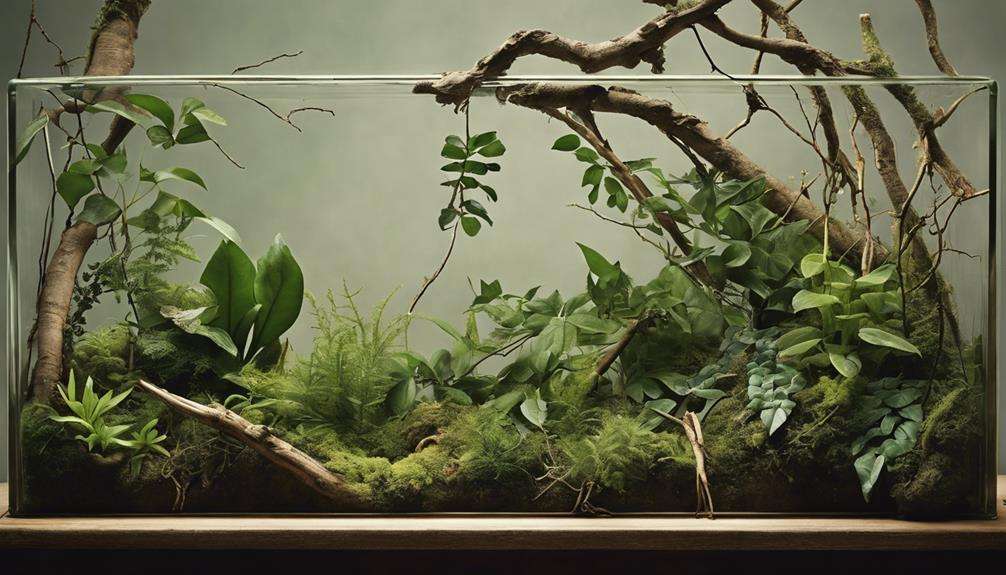
Enhance the environmental complexity within the terrarium to stimulate natural behaviors and well-being in stick insects. To create a stimulating environment, incorporate enrichment activities that mimic their natural habitat. Provide naturalistic decor such as branches, leaves, and foliage to offer climbing opportunities and hiding spots. This setup encourages stick insects to exhibit their behavioral adaptations, like climbing and seeking shelter.
Promote foraging behavior by offering a variety of leaves for them to feed on. Mimicking their natural foraging habits not only keeps them engaged but also meets their nutritional needs. Environmental stimulation is key to maintaining their well-being and overall health.
Ensure the terrarium has adequate ventilation, especially with mesh tops, to prevent stagnant air and maintain proper respiratory health for stick insects. Monitoring temperature, humidity, and cleanliness in the controlled terrarium environment is essential for providing the best conditions. By creating a diverse and engaging habitat, you can observe and appreciate the fascinating behaviors of stick insects in captivity.
Tips for Breeding Stick Insects in Captivity
When breeding stick insects in captivity, ensuring the proper setup of the breeding environment is vital for their reproductive success.
You should carefully monitor the growth progress of the stick insects to track their development and guarantee ideal conditions.
Maintaining a close eye on factors like temperature, humidity, and diet is essential to support healthy breeding outcomes.
Breeding Environment Setup
Maintain consistent humidity levels ranging between 60-70% to establish an ideal breeding environment for stick insects in captivity. Proper humidity supports the molting process important for breeding success.
Provide a spacious terrarium with vertical space for successful molting. Use coco fibre and orchid bark substrate to retain moisture, aiding in egg laying.
Guarantee a well-ventilated lid on the terrarium to create a healthy breeding habitat. Ventilation is key to preventing mold growth and maintaining air quality.
Monitoring temperature and humidity closely is essential for supporting successful breeding and overall stick insect health. By setting up the breeding environment with these factors in mind, you can create an excellent space for stick insects to thrive and reproduce successfully.
Monitoring Growth Progress
To effectively monitor the growth progress of stick insects in captivity, regularly measure their length to accurately track development stages. By implementing precise growth tracking techniques, such as noting developmental milestones and keeping detailed records of molting frequency and duration, you can guarantee proper progress monitoring methods.
Observing any changes in coloration or behavior serves as valuable indicators of growth and development in stick insects. Utilizing a growth chart or spreadsheet to document growth milestones allows for comparison with standard growth rates.
For further guidance on monitoring growth progress, consult breeding guides or experts who can provide specific tips tailored to the needs of stick insects in your terrarium.
Frequently Asked Questions
What Are the Benefits of a Stick Bug?
Stick bugs offer numerous benefits. Their camouflage abilities are fascinating, making them great to observe. They require low maintenance and display interesting behavior. These qualities make stick insects ideal for terrariums, providing a unique and educational experience.
What Is the Best Habitat for Stick Insects?
For stick insects, the best habitat includes maintaining proper temperature levels, humidity, and feeding habits. Assure the terrarium's dimensions are suitable for molting success and overall well-being. Opt for a glass enclosure with a mesh roof and appropriate substrate.
How Is a Stick Insect Adapted to Survive in Their Habitat?
In their habitat, stick insects use intricate camouflage techniques to survive. Their adaptation includes mimicking sticks or leaves, slow movement, cryptic coloration, and specialized appendages resembling plant parts. These features aid in protection and concealment from predators.
What Is the Point of a Stick Insect?
Stick insects, with their remarkable camouflage capabilities, intriguing feeding habits, and unique reproduction methods, serve as marvels of nature. Observing them in a terrarium setting provides insight into their intricate adaptations and behaviors.
Conclusion
As you carefully observe the intricate movements of your stick insects in their terrarium, you may notice a remarkable coincidence – their ability to blend seamlessly into their surroundings, just like a real stick or leaf.
This uncanny resemblance adds a layer of complexity to your terrarium experience, highlighting the fascinating world of camouflage in the insect kingdom.
Embrace this coincidence as you continue to provide a stimulating environment for your stick insects to thrive in captivity.

